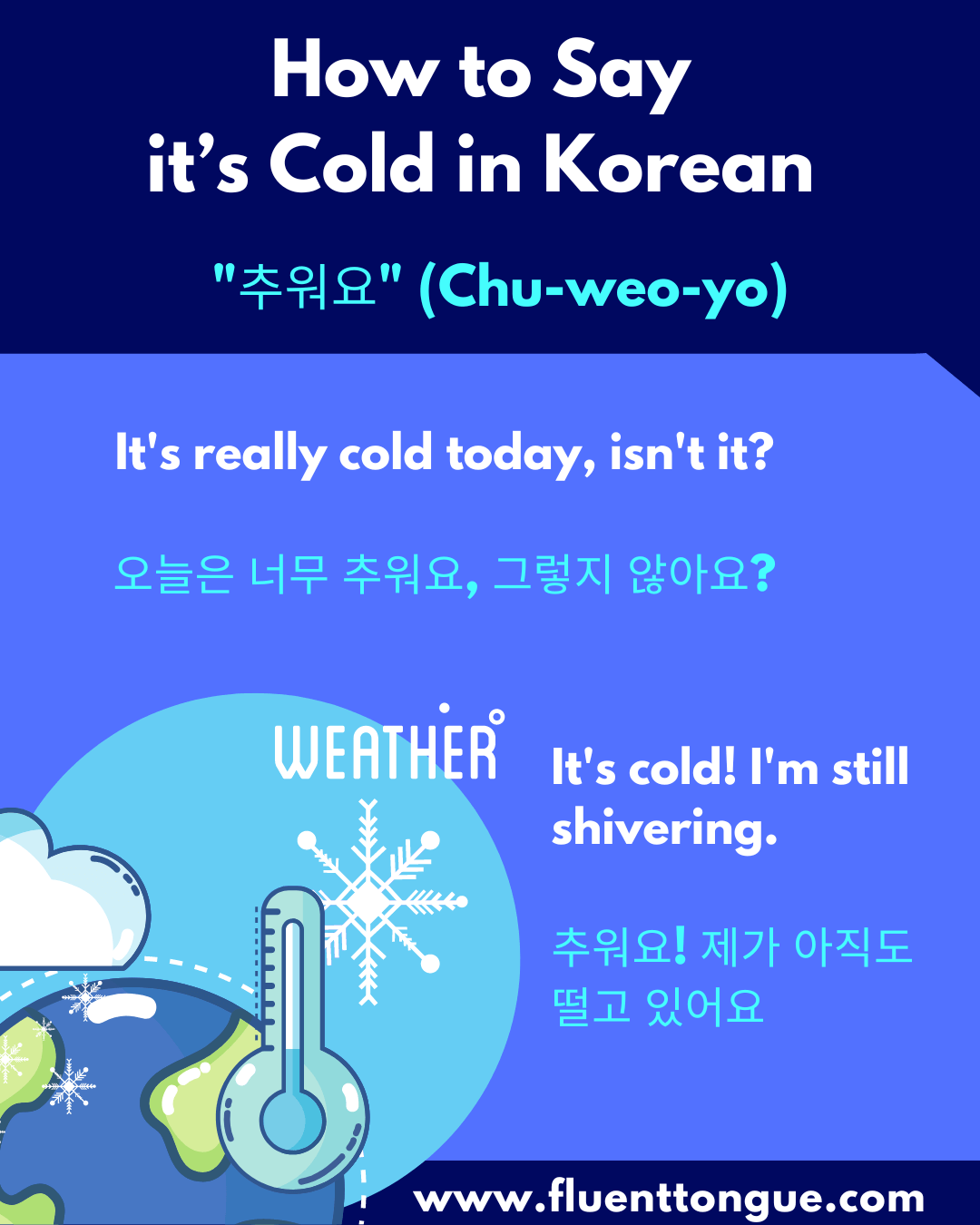Climate is an important subject in on a regular basis dialog, and it’s no totally different when talking Korean.
Studying how one can discuss concerning the climate in Korean shouldn’t be solely an effective way to have interaction in small discuss with pals or household, however it additionally helps you perceive the native tradition and plan your journey to South Korea higher.
On this complete information, we’ll cowl all the pieces it’s essential to know concerning the seasons and climate in Korean, together with vocabulary, phrases, idioms, and one of the best time to go to the nation.
Alright world, let’s dig into the core.
Why You Ought to Be taught How you can Say Climate in Korean

Whether or not you’re a newbie or a complicated learner, figuring out how one can talk about the climate in Korean can improve your language expertise and make you are feeling extra comfy in numerous conditions.
Listed here are some the explanation why you must be taught weather-related Korean phrases:
- Small discuss: The climate is a common subject that may simply break the ice in conversations with native audio system.
- Cultural understanding: Climate performs a vital function in Korean customs, traditions, and festivals. By studying associated vocabulary, you may higher admire the native tradition.
- Journey planning: Understanding the climate patterns in South Korea will make it easier to determine the finest time to go to and pack the proper garments on your journey.
- Actual-life conditions: Discussing the climate is a sensible talent that may turn out to be useful whereas buying, eating out, or asking for instructions.
How you can say climate in korean?

The Korean phrase for ‘climate’ is “날씨” (Nal-ssi). So, the following time you’re gearing up for a chat about whether or not it’s sunny, wet, or something in between, you’re all set with “날씨” up your sleeve.
Instance
How’s the climate right now?
오늘 날씨가 어때요?
The climate is good, so I wish to go for a stroll.
날씨가 좋아서 산책하러 가고 싶어요
It looks as if the climate will likely be cloudy tomorrow.
내일 날씨가 흐릴 것 같아요.
The climate is simply too sizzling, I’ll activate the air conditioner.
날씨가 너무 더워요, 에어컨을 켜요
On wet climate days, it’s good to relaxation at dwelling.
비가 오는 날씨에는 집에서 쉬는 것이 좋아요.
How you can Ask “How is the climate in Korean”?

Earlier than diving into the climate vocabulary, let’s be taught how one can ask about the climate in Korean.
The commonest technique to ask “How is the climate?” in Korean is:날씨 어때요? (Nalssi eottaeyo?)
You may as well ask concerning the climate for a selected day
Instance
How’s the climate right now?
오늘 날씨 어때요? (Oneul nalssi eottaeyo?)
How’s the climate tomorrow?
내일 날씨 어때요? (Naeil nalssi eottaeyo?)
The climate is nice
날씨가 좋아요” (nalssiga joayo)
The climate shouldn’t be good
날씨가 안 좋아요” (nalssiga an joayo)
The climate is de facto good
날씨가 참 좋아요” (nalssiga cham joayo)
The climate is de facto unhealthy”.
날씨가 참 안 좋아요” (nalssiga cham an joayo)
It seems just like the climate is nice
날씨가 좋은 거 같아요” (nalssiga joeun geo gatayo)
It seems just like the climate shouldn’t be good
날씨가 안 좋은 거 같아요 (nalssiga an joeun geo gatayo)
15 Korean Phrases to Describe the Climate in Korean

Listed here are 15 frequent climate situations you may encounter in South Korea and their Korean translations:
- 더워요 (Deo-weo-yo) – It’s sizzling.
- 추워요 (Chu-weo-yo) – It’s chilly.
- 비가 와요 (Bi-ga wa-yo) – It’s raining.
- 눈이 와요(Nun-i wa-yo) – It’s snowing.
- 흐려요 (Heu-ryeo-yo) – It’s cloudy.
- 따듯해요 (tda-deut-hae-yo) — heat
- 바람 불어요 (ba-ram boo-ruh-yo) — windy
- 비가 와요 (bi-ga wa-yo) — wet
- 습해요(Seup-hae-yo) – It’s humid.
- “맑아요” (Malga-yo) – It’s clear.
- 안개가 짙어요” (Angaega jit-eo-yo).- it’s foggy
- 쌀쌀하다 (ssalssalhada) – Chilly
- 서늘하다 (seoneulhada) – Cool
- 천둥번개가 쳐요” (Cheon-dung-beon-gae-ga chyeo-yo).-thunderstorm
- 폭풍우가 몰아쳐요” (Pok-pung-u-ga mol-a-chyeo-yo).- it’s stormy.
- “폭염이에요” (Pok-yeom-i-e-yo) – It’s a heatwave.
- “한파가 왔어요” (Han-pa-ga wat-seo-yo) – A chilly wave has come.
Widespread Korean Phrases for Speaking about the Climate
Now that you recognize the fundamental climate situations in Korean, let’s be taught some phrases for describing the climate extra precisely:
Instance
It’s a fantastic day
날씨가 아주 좋아요 (Nalssi ga aju joayo)
The sky is obvious
하늘이 맑아요 (Haneuri malga yo)
It’s cloudy however not raining
구름이 꼈지만 비가 오지 않아요 (Gureumi kkyeotjiman biga oji anayo)
It’s raining closely
비가 많이 와요 (Biga mani wayo)
The snow is falling gently
눈이 가볍게 내리고 있어요 (Nuni gabyeopge naerigo isseoyo)
The wind is robust
바람이 강해요 (Barami ganghaeyo)
There’s a number of fog
안개가 많아요 (Angaega manayo)
The climate is getting colder
날씨가 추워져요” (nalssiga chuwojyeojyo)
The climate has gotten heat
날씨가 따뜻해졌어요” (nalssiga ttatteuthajyeosseoyo)
It’s sunny right now.
오늘은 맑아요. (o-neul-eun mal-a-yo)
It’s going to rain tomorrow.
내일은 비가 올 거예요. (nae-il-eun bi-ga ol geo-ye-yo)
It’s sizzling right now.
오늘은 더워요. (o-neul-eun deo-weo-yo)
It’s going to be chilly tomorrow.
내일은 추워요. (nae-il-eun chu-weo-yo)
How you can say it’s sizzling in Korean | Sizzling climate in Korean

Whenever you’re feeling the warmth and also you wish to say “It’s sizzling” in Korean, you’ve acquired to say “더워요” (Deo-weo-yo).
So when the solar’s scorching and also you’re reaching for that iced tea, you recognize what to say.
Instance
I used to be about to exit, however it’s actually sizzling!
외출하려니까, 정말 더워요
It’s actually sizzling right now, isn’t it?
오늘은 정말 더워요, 그렇지 않나요?
It’s sizzling! I’m sweating loads
더워요! 많이 땀이 나요
How you can say It’s Chilly in Korean | Chilly climate in Korean

When the chilly wind is biting and also you wish to say “It’s chilly” in Korean, you’d go together with “추워요” (Chu-weo-yo). So while you’re shivering and reaching for that sizzling cup of cocoa, you’ve acquired the right phrase to make use of.
Instance
I simply stepped outdoors, it’s actually chilly!
나가 보니까, 정말 추워요!
It’s actually chilly right now, isn’t it?
오늘은 너무 추워요, 그렇지 않아요?
It’s chilly! I’m nonetheless shivering.
추워요! 제가 아직도 떨고 있어요.
How you can describe wet climate in korean

Whenever you wish to say it’s raining, you’d say “비가 와요” (Bi-ga wa-yo). Listed here are some examples to get you splashing by these puddles:
Instance
I used to be about to exit, however it’s raining!
외출하려고 했는데, 비가 와요!
It’s raining right now, so it’s essential to carry an umbrella.
오늘은 비가 와서 우산을 가져와야 해요.
It’s a bit chilly as a result of it’s raining.
비가 와서 날씨가 좀 쌀쌀해요.
I like searching the window when it’s raining.
비가 와서 창밖을 보는 것이 좋아요.
The roads are slippery as a result of it’s raining.
비가 와서 도로가 미끄러워요.
Summer time Climate Vocabulary and Phrases

Summer time in South Korea is sizzling and humid, with a wet season referred to as 장마 (jangma) in July.
Listed here are some helpful summer season climate phrases and phrases:
- Wet season: 장마 (Jangma)
- Heatwave: 폭염 (Pokyeom)
- Sunscreen: 자외선 차단제 (Jaoesaeon chadanje)
- Umbrella: 우산 (Usan)
- Air conditioner: 에어컨 (Aeokeon)여름 (Yeoreum): Summer time
- 더위 (Deowi): Warmth
- 햇볕 (Haetbyeot): Sunshine
- 더운 (Deoun): Sizzling
- 습도 (Seupdo): Humidity
- 태양 (Taeyang): Solar
- 해변 (Haebyeon): Seashore
- 시원한 (Siwonhan): Cool (as in temperature)
- 비 (Bi): Rain
- 소나기 (Sonagi): Bathe (rain)
- 아이스크림 (Aiseukeurim): Ice cream
- 선크림 (Seonkeurim): Sunscreen
- 모자 (Moja): Hat (to guard from the solar)
- 선크림을 바르다 (Seonkeurimeul bareuda): Apply sunscreen
- 선풍기 (Seonpunggi): Fan
- 에어컨 (Eeokon): Air conditioner
- 물놀이 (Mullnoli): Water play
- 수영장 (Suyeongjang): Swimming pool
- 수박 (Subak): Watermelon (a standard summer season fruit in Korea)
- 피크닉 (Peeknik): Picnic
Instance phrases:
날씨가 너무 더워요 (Nalssi ga neomu deowoyo)
The climate is simply too sizzling
에어컨을 틀어주세요 (Aeokeoneul teoreojuseyo)
Please activate the air conditioner
장마 때문에 비올 것 같아요 (Jangma ttaemune biol geot gatayo)
It looks as if it can rain as a result of wet season
Fall Climate Vocabulary and Phrases

Autumn in Korea is known for its lovely foliage and delicate temperatures. Listed here are some fall climate phrases and phrases:
- Autumn leaves: 단풍 (Danpung)
- Cool climate: 서늘한 날씨 (Seoneulhan nalssi)
- Jacket: 재킷 (Jaekit)
- 가을 (Gaeul): Autumn
- 시원한 (Siwonhan): Cool
- 바람 (Baram): Wind
- 바람이 불다 (Barami buda): The wind blows
- 낙엽 (Nagyeop): Fallen leaves
- 단풍 (Danpung): Autumn leaves/ Fall foliage
- 우산 (Usan): Umbrella
- 비올레차 (Biollecha): Violet tea (a conventional fall drink in Korea)
- 장마 (Jangma): Monsoon
- 구름 (Gureum): Cloud
- 안개 (Angae): Fog
- 단풍놀이 (Danpungnori): Leaf peeping/ Going to see the autumn leaves
- 미세먼지 (Misemeonji): Effective mud (typically a difficulty in Korea within the fall)
- 추워지다 (Chuwojida): To turn out to be chilly
- 옷을 더 입다 (Oseul deo ipda): To placed on extra garments
- 수프 (Supeu): Soup (standard meals in fall)
- 스웨터 (Seuweteo): Sweater
- 재킷 (Jaekit): Jacket
- 털실 (Teolsil): Wool (as in woolen garments)
- 코트 (Koteu): Coat
Instance phrases:
가을 날씨가 좋아요 (Gaeul nalssi ga joayo)
I like autumn climate
단풍이 예쁘네요 (Danpungi yeppeuneyo)
The autumn leaves are lovely
Winter Climate Phrases and Phrases

Winters in South Korea might be fairly chilly, with snowfall in some areas. Listed here are some winter climate phrases and phrases:
- Snow: 눈 (Nun)
- Ice: 얼음 (Eoreum)
- Chilly: 춥다 (Chupda)
- Heater: 히터 (Hiteo)
- 겨울 (Gyeoul): Winter
- 눈 (Nun): Snow
- 추운 (Chuun): Chilly
- 얼음 (Eoreum): Ice
- 바람 (Baram): Wind
- 한파 (Hanpa): Chilly wave
- 눈보라 (Nunbora): Snowstorm
- 설경 (Seolgyeong): Snowscape
- 눈사람 (Nunsaram): Snowman
- 스카프 (Seukapeu): Scarf
- 장갑 (Janggap): Gloves
- 모자 (Moja): Hat
- 코트 (Koteu): Coat
- 미끄럼 (Mikkeureom): Slip (as in slipping on ice)
- 패딩 (Paeding): Padded jacket (standard in Korea throughout winter)
- 스키 (Seuki): Ski
- 눈뭉치싸움 (Nunmungchissawum): Snowball combat
- 털실 (Teolsil): Wool (as in woolen garments)
- 난방 (Nanbang): Heating
- 핫팩 (Hatpaek): Warmth pack
Instance phrases:
눈이 많이 왔어요 (Nuni mani wasseoyo)
It snowed loads
겨울에는 난방이 필요해요 (Gyeoureneun nanbangi piryohaeyo)
Heating is important in winter
Spring Climate Phrases and Phrases

Spring in Korea is a fantastic season with blooming flowers and nice temperatures. Listed here are some spring climate phrases and phrases:
- Cherry blossoms: 벚꽃 (Beotkkot)
- Yellow mud: 황사 (Hwangsa)
- Pollen allergy: 꽃가루 알레르기 (Kkotgaru allereugi)
- 봄 (Bom): Spring
- 따뜻한 (Ddaddeushan): Heat
- 꽃 (Kkot): Flower
- 벚꽃 (Beotkkot): Cherry blossom
- 비 (Bi): Rain
- 봄비 (Bombi): Spring rain
- 나비 (Nabi): Butterfly
- 풀잎 (Pulnip): Grass
- 신록 (Sinrok): Contemporary inexperienced (used to explain the colour of spring crops)
- 햇빛 (Haetbit): Sunshine
- 녹색 (Noksaek): Inexperienced colour
- 봄나들이 (Bomnaduri): Spring outing
- 청량한 (Cheongryanghan): Refreshing
- 야외 (Yaoe): Outdoor
- 새싹 (Saessak): Sprout
- 장마 (Jangma): Monsoon, also referred to as “spring rain” in Korea
- 피크닉 (Peeknik): Picnic
- 우산 (Usan): Umbrella
- 햇살 (Haetsal): Daylight
- 계절의 변화 (Gyejeol-ui byeonhwa): Change of seasons
Instance phrases:
봄에 꽃이 피어요 (Bome kkochi pieoyo)
Flowers bloom in spring
황사 때문에 마스크를 써야 해요
(Hwangsa ttaemune maseukeureul sseoya haeyo)
You need to put on a masks as a result of yellow mud
Other than the fundamental adjectives, there are numerous weather-related phenomena you might wish to talk about in Korean:
- 구름 (gureum) – Cloud
- 비 (bi) – Rain
- 홍수 (hongsu) – Flood
- 눈 (nun) – Snow
- 얼음 (eoreum) – Ice
- 우박 (ubak) – Hail
- 안개 (angae) – Fog
- 무지개 (mujigae) – Rainbow
- 지진 (jijin) – Earthquake
Understanding Korean Seasons
Korea is a rustic with 4 distinct seasons, every providing one thing distinctive and exquisite. To begin our journey in discussing the climate in Korean, let’s familiarize ourselves with the totally different seasons.
1.1 봄 (bom) – Spring
Spring in Korea usually happens from March to Could. That is the right time to witness the breathtaking cherry blossoms and take beautiful selfies with the picturesque backdrop. The height time for cherry blossoms is normally from mid-March to early April.
1.2 여름 (yeoreum) – Summer time
Summer time in Korea lasts from June to August, with temperatures hovering and humidity ranges rising. The Korean 장마 (jangma) or wet season normally takes place in the course of June to July, so it’s important to have an umbrella and raincoat helpful throughout this time. As temperatures can rise to 40℃, it’s essential to put on gentle and breathable clothes.
1.3 가을 (gaeul) – Fall
From September to November, Korea’s fall season showcases beautiful hues of crimson, orange, and yellow as leaves change colour. This is a perfect time to go to locations like Nami Island to seize the great thing about autumn on digital camera.
1.4 겨울 (gyeoul) – Winter
Winter in Korea spans from December to February, with snow usually showing round late November. Koreans consider that witnessing the primary snow of the 12 months with a beloved one will carry real love and happiness. In consequence, the primary snowfall typically sparks romantic meetups and declarations of affection.
The Korean language has many idioms associated to climate, which may add colour and depth to your conversations.
Listed here are a couple of examples:
- 하늘을 지붕 삼다 (Haneureul jibung samda)
To make the sky a roof (to be a wanderer or homeless)
- 꽃샘추위 (Kkotsaemchuwi)
The chilly envies the flowers (a sudden chilly spell in spring)
- 바람을 넣다 (Baram-eul neohda)
To place in wind (to encourage or inspire somebody)
- 비오는 날 사나이 (bi-o-neun nal sa-na-i)
A person on a wet day. This idioms means an individual who reveals his true colours throughout troublesome occasions.
- 눈오는 날 그림자 (nun-o-neun nal geu-rim-ja)
A shadow on a snowy day. This idioms means an individual who stands out throughout troublesome occasions.
- 구름 가득한 날 (gu-reum ga-deuk-han nal)
A day filled with clouds. This idioms means a day that’s gloomy or filled with worries.
- 해맑은 날 (hae-mal-geun nal) -A sunny day.
This idiom means a great day, a day of fine luck or a day of happiness.
- 바람 불어오는 날 (ba-ram bul-eo-o-neun nal)
A windy day. This idiom means a changeable day, a day when issues are unpredictable.
It’s essential to notice that these idioms are utilized in particular conditions and will not be at all times actually translated.
So it’s finest to observe with native audio system or to make use of language-learning apps to grasp the utilization in context.
How To Say Temperature In Korean
The phrase for ‘temperature’ in Korean is “온도” (On-do).Whenever you wish to specific “5 levels” in Korean, you say “오도” (O-do).”15 levels” in Korean is “십오도” (Ship-o-do).”35 levels” can be “삼십오도” (Sam-ship-o-do).
Listed here are a couple of instance sentences utilizing particular temperatures in Korean
Instance
오늘 온도는 삼십오도입니다
Immediately’s temperature is 35 levels
“오늘 온도는 오도입니다
Immediately’s temperature is 5 levels.
“내일 온도는 십오도가 될 것 같아요.
The temperature will likely be 15 levels tomorrow.
Greatest Time to Go to South Korea | Climate by Month
The very best time to go to South Korea is determined by your preferences and the actions you wish to do. Right here’s a fast overview of the climate by month:
- March-Could (Spring): Splendid for cherry blossom viewing and having fun with delicate temperatures.
- June-August (Summer time): Sizzling and humid, with the wet season in July. Good for seashore journeys and water sports activities.
- September-November (Fall): Cooler temperatures and beautiful foliage make this a preferred time for mountain climbing and sightseeing.
- December-February (Winter): Chilly and snowy, ideally suited for snowboarding and winter sports activities.
Now that you just’re geared up with complete information concerning the climate in Korea, you may confidently interact in conversations with native audio system and plan your journey to South Korea with your loved ones in line with the climate situations.
Observe these phrases and phrases, and also you’ll quickly grasp the artwork of discussing the climate in Korean!
Conclusion
“And there you may have it, people! Your primer on expressing ‘climate in Korean.’
From the warmth of summer season (Yeoreum) to the coolness of winter (Gyeoul), the great thing about spring (Bom), and the serenity of autumn (Gaeul), we’ve lined all of it.
So whether or not you’re aiming to impress your Korean pals, planning a visit, or settling in Korea, this lingo information for climate in Korean is a superb place to begin.
Keep in mind, it’s extra than simply phrases – it’s about connecting with the tradition and dwelling the Korean manner.
if you wish to observe Korean phrases for climate, listed below are some free sources I discovered on the net

https://quizlet.com/11608732/weather-quizlet-flash-cards/
https://quizlet.com/81141232/weather-and-climate-flash-cards/
Joyful studying, people!”

